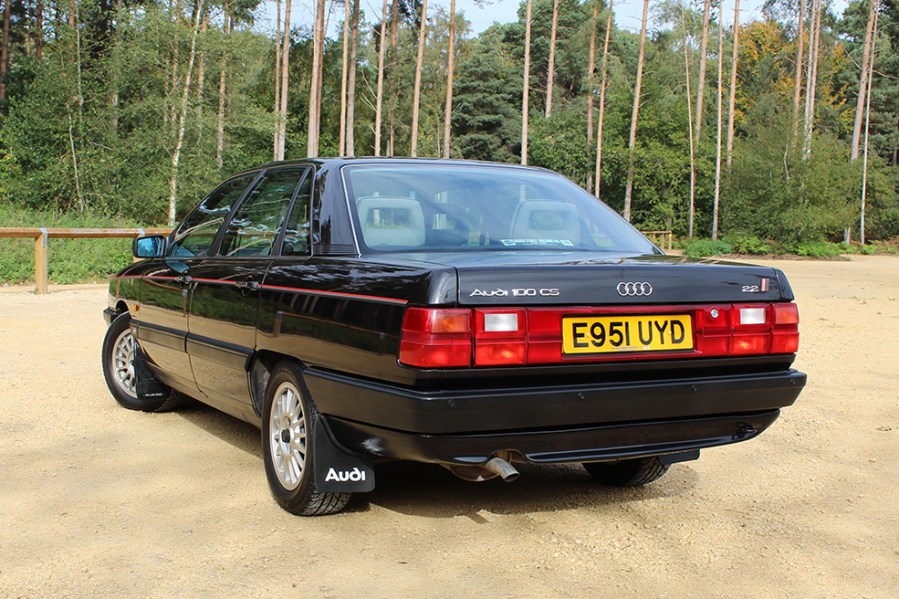The C3-generatiion Audi 100 exemplifies the brand’s transition to a premium brand in the 1980s. How does it hold up today?
Words and images: Jeff Ruggles
When we think of the aerodynamic revolution of the early 80s, Ford’s ‘jelly mould’ Sierra is almost the default position thanks to a stark contrast with its boxy Cortina predecessor. However, it was the C3-generartion Audi 100 that got there first, launched a month earlier than the Ford and setting an even more impressive benchmark for slipperiness.
Arriving in September 1982, the new 100 was also a replacement for something boxier – in this case its squared-off C2 predecessor, though in fairness that was also very streamlined for its time thanks to a drag coefficient of 0.36. However, the new model’s smooth styling and features such as pin-mounted flush windows and faired-in wipers brought this down to as low as 0.30, which made it the most aerodynamic production car in the world at the time and significantly bettered the 0.34 of the Sierra.
The 100 also ushered in other elements that would come to define the class, such a fuel injection for its five-pot engines, lightweight construction with special tempered glass and high-quality plastics, plus its procon-ten safety technology. It was faster and more economical than rivals with similar engine sizes, leading to the rather cheeky 1983 advert that featured a German family getting to Marbella ahead of two other families, and stated: “If you want to get on the beach before the Germans, you better buy an Audi 100…” Another advert showed the 100 with several parachutes attached to the rear to demonstrate what driving a ‘normal’ saloon would be like.
The C3 range would go on to feature a massive range of different models. In August 1983, the Avant estate version arrived, followed by the Audi 200, which featured with body and chassis of the 100, but with more powerful engines and better equipment. The C3 was also a pioneer of permanent quattro all-wheel drive in the upper mid-size class, with so-equipped models appearing from 1984. It all helped Audi to make meaningful inroads on BMW and Mercedes’ turf, but these were not cheap cars. The 100CD was already priced above the Ford Granada 2.8, at about £11,000 in 1983, while the turbocharged 200 quattro of 1985 was no less than £23,043.

Bodyshells were initially part-galvanised but became fully galvanised in 1986, and in January 1988, a major facelift took place, whereby the 100 received a redesigned interior as well as flush-fitting door handles and other small innovations. The C3 also brought the TDI engine into series production for the Volkswagen Group for the first time when it arrived in 1990, before the new C4 model arrived for 1991. The C3 had done its job though, and much like the Audi 80 B3 of 1986, exemplified the beginning of Audi’s development into a technology-focused premium brand.
The C3 we have the pleasure of experiencing is a very late pre-facelift car registered in 1988. Not only that, but it’s a 2.2 CS model, made even racier by virtue of being in rare Sport trim. It immediately caught my eye thanks to the ‘YD’ area code on its original dealer numberplates, which denotes it to be a Somerset car (supplied by Silver Street Motors in Taunton) and hence local to me. However, it had found its way to specialist dealer Kim Cairns in Snettisham, Norfolk, where it had been prepared to a very high standard.
According to the brochure, the 100 Sport was aimed at discerning owners who wanted a “sporting edge to their luxury motoring” but “without compromising the 100 range’s exceptional refinement.” Audi played on its 1-2 victory in the 1987 Safari Rally in tuning the suspension specifically to the Sport, dropping the ride height by 15mm courtesy of shorter and stiffer springs, tweaking the damper settings and fitting the alloy wheels with wider 205-section tyres. On this car, the five-spoke Sport wheels have been replaced by smart Ronal alloys as also fitted to the top of the range Audi 100 CS quattro of the period.
Under the bonnet is the lusty 2.2-litre five-cylinder engine producing 138bhp, making it good for book figures of 0-60mph in 9.6 seconds and a top speed of 126mph. The gearbox is a five-speed manual, which was the sole choice for the Sport model. These performance credentials are shown externally with what Audi calls “measured discretion,” with only a tasteful Audi Sport badge on the bootlid and a full-width extension piece for the red rear light clusters to mark it out, though this car also has subtle dealer-fitted stripes too. Inside you get sporter front seats and a leather-rimmed four-spoke steering wheel, which looks great despite being a little at odds with the rather staid dash design.

Clearly a well-kept example and showing a relatively low mileage of just over 90,000 miles, the car looks and feels as if it’s wanted for nothing over the last 35 years and as such offers a great chance to sample it just as it would’ve been back in 1988. Hop in for a drive and it immediately feels modern, belying its 40-year-old design and immediately convincing you of its capability to be an everyday classic. It even has parking sensors!
Once warmed up, the warbly five-pot whisks you up to the national limit with ease, and the gear-change is smooth and precise, with a clutch that’s not too heavy. At one point we had to join a busy carriageway that necessitated putting the car’s pace to the test, and it wasn’t found wanting.
Get to the twisty stuff and you can enjoy responsive steering and safe, neutral handling. The ride is good too, adding to the feel that this is a solidly built machine. Indeed, we struggled to find anything amiss, with that galvanised bodywork rust-free and the paint still in excellent order. Think of a larger take on the Mk2 Golf GTI Mk2 and you are on the right track as towards how this car feels, but with a better noise, more room and a greater journey ability to cope with long journeys thanks to increased refinement, a large fuel tank and reasonable consumption. It’s not particularly rapid by today’s fast saloon standards, but it makes for an excellent all-rounder. It’s car we could comfortably drive all day, but you’ll need to factor in extra time for the conversations with strangers it will inevitably trigger.
This particular example has found a new owner since our drive, and we can’t say we’re surprised to see it snapped up. Don’t go expecting to snap up a Sport easily should you fancy one – there can’t be more than around 25 of these cars remaining in the UK, with only a couple currently licenced. However, we’re confident that any C3 will make an excellent choice as a useable and practical modern classic thanks to impressive reliability and longevity. For once, you can put the welder away.






